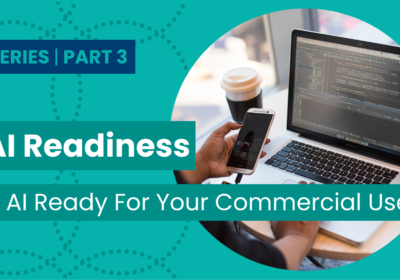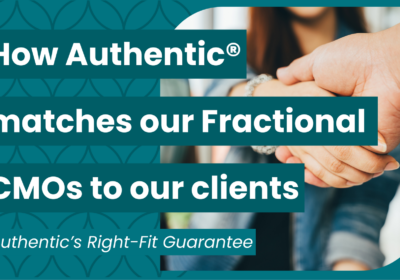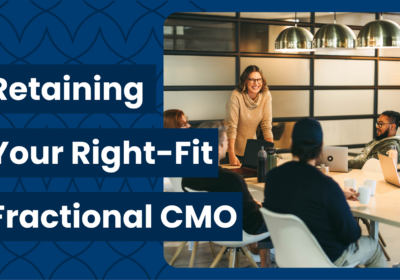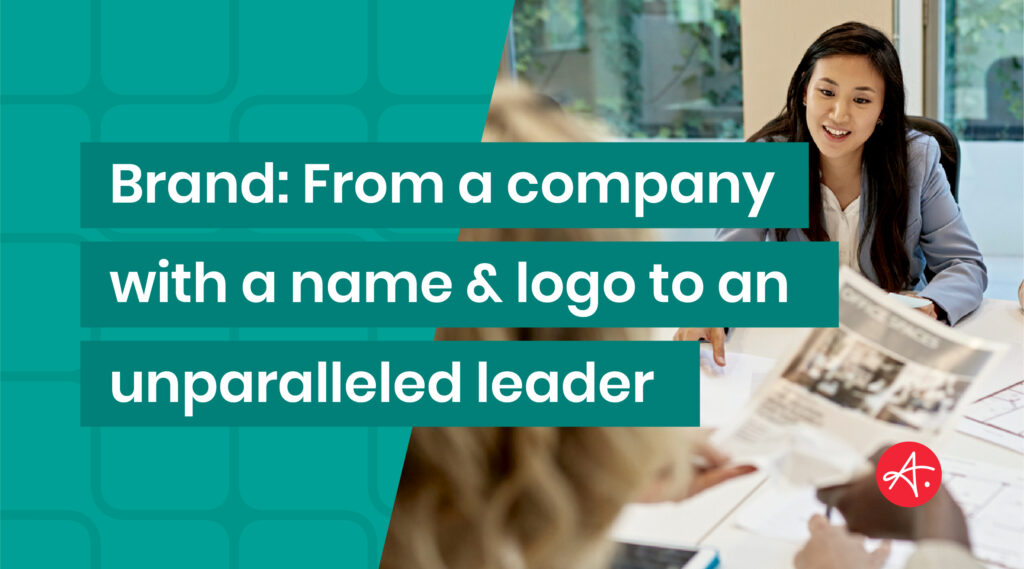
What, exactly, is a “brand”?
Brand is a squishy word that means a lot of different things to a lot of different people. When we’re working with entrepreneurial companies, their concept of “brand” is often that it’s the company’s logo, color palette, and font styles. In other words, the general look and feel of the business. But as a company grows, leaders must broaden their understanding of brand if they hope to mature successfully and become an unparalleled leader in their category.
Here’s how we define brand: A brand is the promise a company makes to the world and how the world experiences the delivery (or lack thereof) of that promise. Stakeholders experience your brand in every interaction they have with your business.
Companies that evolve their understanding of brand from visual aesthetics to the holistic experience and delivery of a promise can generate significant business value. But this isn’t an easy or quick journey. At Authentic, we use our Authentic Growth™ Marketing Maturity Matrix to show the stages of maturity a business must go through to understand its unique value, deliver on its promise, and ultimately become a known, trusted, and unparalleled leader.
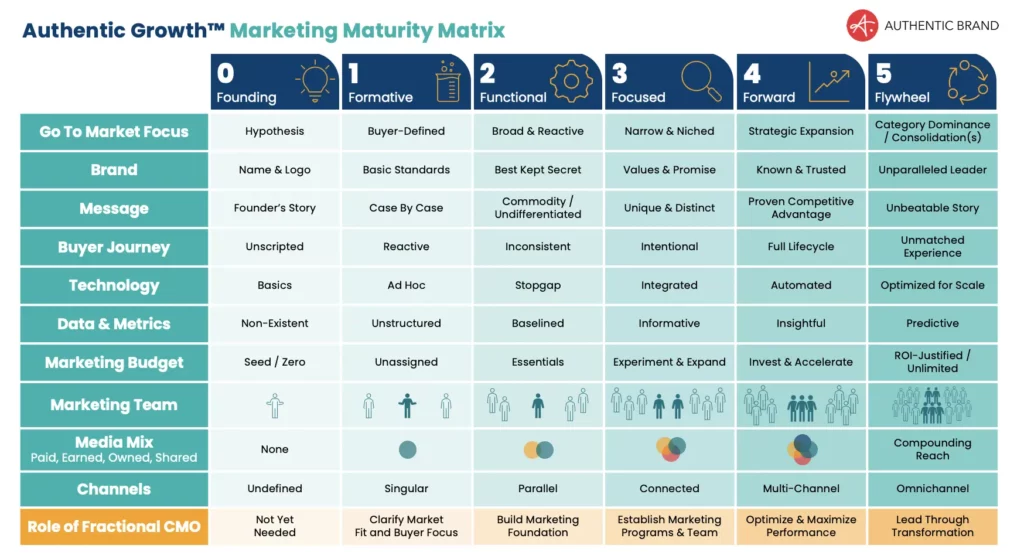
The path to becoming an unparalleled leader: Stages 0 to 5
Building a high-value brand often begins with creating a consistent and high-quality visual aesthetic but soon becomes much more than just creative assets. Your brand must have a differentiated, authentic, and compelling story that it shares with the people who matter most to the company. Once that story is heard and understood, and your brand is trusted and known, you must stay tuned into changing market dynamics that will require innovation to continue appealing to your buyers.
The following six stages demonstrate how a company moves through this progression.

Stage 0: Founding – Name & logo
In the early stages of a business, many founders are thinking about their brand simply in terms of what they will name their company, what their logo will look like, what colors they’ll use, and maybe even specific font choices or styling. That’s usually about as far as they get with the brand, sometimes iterating on the name and logo several times in the company’s early stages.
Meanwhile, some entrepreneurs become business owners by accident. They might be working a side hustle, special gig, or project and, at some point along the way, recognize a business opportunity. Eventually, they realize they need a name and a business structure. At that point, branding becomes important.
How to mature to the next stage: Most importantly, this is the time to recognize that you are a company. The first step to becoming a recognized entity is to file and register your business name with your state. You may also choose to file a DBA (doing business as). For example, Authentic’s business name is “Authentic LLC,” but we also filed a DBA for “Authentic.”
This is also the stage to think about logo design. Some startups have the design chops to do it themselves, but typically, we recommend that you hire a graphic design professional. For bootstrapping startups, affordable options available through the gig economy, like Fiverr and Upwork, are popular options at this stage.
What you’ll need: Business name registered with your state, filed DBAs (if applicable), and a capable designer experienced in logo or brand design.

Stage 1: Formative – Basic standards
Even beyond a brand’s launch, early-stage businesses often still focus on the brand as a creative concept — the logo and the company’s look and feel. But even this narrow focus can get messy fast.
Early-stage companies are notorious for throwing things together themselves and iterating numerous times. They pair new taglines with the logo to accommodate a pivot or one-off project, edit the logo for a new format, and test out a new shade of blue. Often, no one’s sure what or where the correct version is or whether there are any rules at all.
Logos have legs, and even for a small, early-stage company, it doesn’t take long for these varied logos to end up in many places, in many forms and applications. The result? Brand confusion when someone searches for your company.
How to mature to the next stage: Put guardrails around your brand to slow the chaos of your visual assets and alleviate brand confusion. Do this by partnering with someone experienced in branding to create brand guidelines that’ll help your brand mature to the next level through consistently applied design.
Document your brand standards in a one to two-page document that compiles your fonts, colors, allowable logo versions (e.g., horizontal, vertical, reverse use), and brand mark (your logo icon). It could also include approved supporting content (e.g., tagline), industry terms, trademarks, and other design elements, like illustrations or patterns.
It’s also important to be thoughtful about SEO and logo file tagging so the correct version of your logo shows up when people search for you. Share this document with anyone who represents your brand through design or creative services (including partners).
What you’ll need: Basic brand standards guide, created in partnership with someone experienced in branding, as well as guidance for digital use and SEO implications

Stage 2: Functional – Best kept secret
As your brand comes into contact with more people, your story is being shared more broadly. All of those people now have some perception of your brand, but it might not be the same perception across the board. Why? Because you haven’t yet clarified and documented your brand’s promise in a way that enables consistent storytelling.
You likely have a good sense of what you want your brand to stand for and the value it can bring to the world. But you may feel like the “best kept secret” because people beyond your clients, partners, and employees might not know you exist or what you solve.
How to mature to the next stage: Start thinking about your brand as much more than a logo and color palette. Your brand represents the experience and value the company delivers through every interaction with every stakeholder. Answer these questions:
- What is the promise your business is making to the world?
- Who matters to you?
- Why should you (your business) matter to them?
This is also the stage at which many businesses start investing in strategic marketing because they need to clarify and refine their ideal target. When you have a tighter grasp of your ideal target audience, you can point your resources (e.g., time, money, and energy) in a more specific direction, helping your brand reach the communities that matter while eliminating waste in the wrong directions.
What you’ll need: Understanding of who matters to you and why you should matter to them, clarity on your ideal buyer (and employee, partners, or other relationships), and an experienced marketer to lead you through these decisions so you direct your resources effectively.

Stage 3: Focused – Values & promise
You now know whom you’re pursuing, but many of your targeted buyers still don’t know who you are or why you should matter to them. Engaging them comes down to telling a compelling, unique, and differentiated brand story. Brand messaging becomes critical to help your ideal customer understand who you are — and convince them to believe you’re worth their time.
How to mature to the next stage: Clarity on the competitive ecosystem is critical at this stage to understand who and what you’re competing against. Mapping out competitors helps you compare them side-by-side to identify whitespace where your brand can authentically shine and deliver value in a way no competing brand can.
Your organization should also be clear on its values. These values should be authentic, not aspirational, and grounded in what you believe and how you already deliver on your promises.
Finally, consider whether there’s a specific guarantee or type of experience you are committed to providing. This guarantee should be articulated in your business plan, documenting how you want your brand to show up in the world so it can deliver its differentiated value.
If you don’t have a strategic business plan yet, create one. This business plan should be a living, dynamic plan, but your purpose should remain steady. Many companies adopt a business operating system at this time to operationalize their purpose, guarantee, and brand experience.
What you’ll need: Analysis of the competitive ecosystem, a documented strategic business plan anchored in your company’s purpose and supported by your niche (audience + offerings), values, guarantee, and what makes you unique, and a business operating system (such as EOS®) to operationalize your purpose.

Stage 4: Forward – Known & trusted
Becoming a known and trusted brand means sharing your story. And sharing your story means you actively and consistently invest in marketing activities that will bring your brand out into the world. Marketing is how your brand promise gets heard and understood by the right people.
By the time you reach this stage, you have consistently implemented strategic marketing initiatives, learned from them, and refined your marketing plan. More people have seen your brand and understand your story. Through this process, you’ve built trust, and demonstrating this trust is now critical to your marketing program.
How to mature to the next stage: You don’t have to be known and trusted by the world to be successful, but you do need to be known and trusted by the spheres of influence that support healthy growth for your business.
It’s no longer just about your company sharing its story; it’s about amplifying the voices of the people who know and trust you. Demonstrate through proof points how you have delivered on your brand experience and promise. Collect customer (and employee) feedback that proves you provide what you say you will and reinforces your brand’s story. Then, share that back out to the world through marketing campaigns.
Weaving customer testimonials, reviews, case studies, and employee feedback into your marketing plan helps affirm the legitimacy of your brand and carries your message even further. After all, according to recent research from Qualtrics, 93% of customers read online reviews before they purchase a product.
What you’ll need: Documented evidence of success (e.g., customer case studies, online reviews, testimonials, Net Promoter Score®) and marketing programs that remarket that success back out to the world.

Stage 5: Flywheel – Unparalleled leader
Every business owner or founder hopes to build a brand of such value, significance, and impact that it’s recognized as the leader of the pack. To become an unparalleled leader means the quality, sentiment, and experience of your brand are top-notch and superior to competitors. Being the leader doesn’t mean you have to be the largest company in the competitive set, but that stakeholders recognize the consistency and quality you bring to the world as unmatched.
How to continue maturing: Don’t become complacent. Once you establish your brand as the leader, you become a hot target to competitive forces. Be absolutely sure that your intellectual property is well protected and well managed with trademarks, copyrights, and patents.
The world will continue to evolve and change, and so will buyers’ expectations. Stay in tune with what your stakeholder groups think of your brand to assess whether your brand is at risk of slipping or if new competitive dynamics will require a new type of innovation. These feedback loops will help your business continue to create the kind of value that the changing buyer needs.
What you’ll need: Protected intellectual property, feedback loops with stakeholder groups (e.g., surveys, customer advisory panels), teams dedicated to continuous innovation.
Becoming an unparalleled leader requires brand maturity
Building a category-leading brand requires consistency, staying in tune with who your buyers are and what they need, and marketing programs that carry your message to the right people. We created the Authentic Growth™ Marketing Maturity Matrix to show how Authentic guides companies from a business with a name and logo to an unparalleled leader.
Our fractional CMOs understand the broadest definition of brand and help our clients make promises they can feasibly and realistically deliver to build trust one interaction at a time. Trust is the most valuable asset any business can have — and also the most challenging to create. Let’s connect if you’re ready to build an even higher-value and trusted brand.



